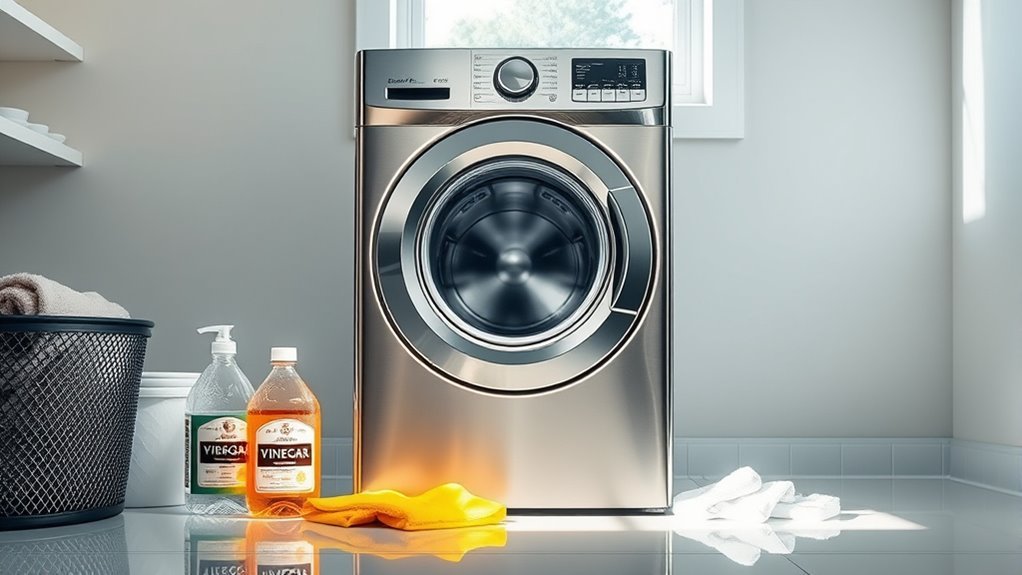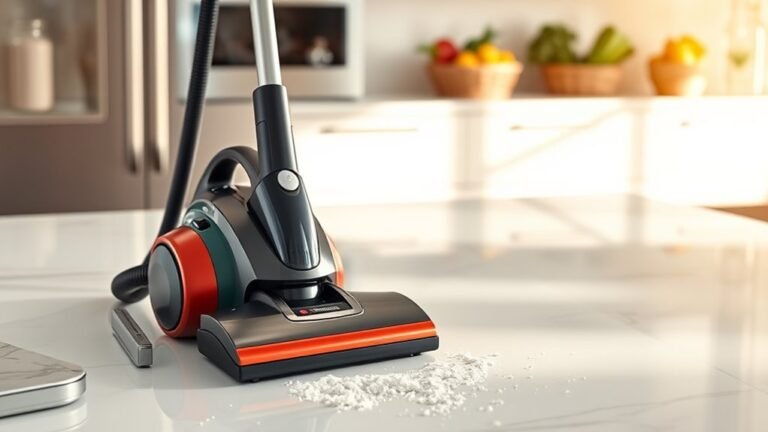Top 10 Tips for Cleaning Washer
You should start by removing and thoroughly cleaning the detergent dispenser to prevent residue buildup. Run a hot water cycle with vinegar monthly to break down deposits and odors. Sprinkle baking soda in the drum for additional odor control. Regularly wipe rubber seals and clean inlet filters to avoid mold and water flow issues. Leave the door open after cycles to allow drying. Don’t forget the exterior and commercial cleaners for deep maintenance. Explore these steps further for ideal washer care.
Remove and Clean the Detergent Dispenser

Before you begin cleaning the detergent dispenser, make certain your washer is turned off and unplugged to avoid any electrical hazards. Start by carefully removing the dispenser tray according to your washer’s manual—this step is essential for effective dispenser maintenance. Over time, detergent buildup can obstruct water flow and reduce cleaning efficiency. Use warm water and a soft brush to scrub away residue, paying close attention to corners and crevices where buildup accumulates. Avoid harsh chemicals that might damage the dispenser components. After cleaning, dry the tray thoroughly before reinserting it to prevent mold growth. Regularly performing this task guarantees your washer operates freely and maintains ideal detergent distribution, giving you the independence to control your laundry’s cleanliness without relying on professional service.
Run a Hot Water Cycle With Vinegar
You should run a hot water cycle with white vinegar to break down mineral deposits and eliminate odors inside your washer. Simply add two cups of vinegar to the drum and select the longest, hottest wash setting without any clothes. Doing this once a month helps maintain your machine’s efficiency and prevents buildup.
Benefits of Vinegar Cleaning
Although many cleaning agents promise to remove buildup, running a hot water cycle with vinegar offers a straightforward and effective solution to dissolve mineral deposits, soap scum, and residue inside your washer. Vinegar benefits include its acidic nature, which breaks down hard water deposits and neutralizes odors, restoring your machine’s efficiency without harsh chemicals. Unlike some vinegar alternatives that rely on synthetic compounds, vinegar is biodegradable and safe for most washer components. This method helps maintain your washer’s performance, prevents mold growth, and extends its lifespan. By choosing vinegar, you embrace a practical, cost-effective cleaning strategy that supports your desire for freedom from expensive, toxic cleaners, ensuring your appliance stays clean and odor-free with minimal effort.
How to Run Cycle
One simple but essential step to cleaning your washer effectively is running a hot water cycle with vinegar. This method breaks down residue and kills odor-causing bacteria, aligning with top washer maintenance tips. Follow this cycle settings guide to optimize results:
- Set your washer to the hottest water temperature available.
- Select the longest wash cycle to allow vinegar enough time to work.
- Pour two cups of white vinegar directly into the drum or detergent dispenser.
- Start the cycle and let it complete fully—avoid adding detergent or laundry.
Frequency of Vinegar Use
Regularly running a hot water cycle with vinegar is essential for maintaining your washer’s efficiency and preventing buildup. Typically, you should perform this cleaning every 1 to 3 months, depending on usage frequency and water hardness. Use white distilled vinegar at a concentration of about 2 cups per cycle. If you prefer vinegar alternatives, such as citric acid or baking soda, adjust quantities accordingly.
| Frequency | Vinegar Concentration | Vinegar Alternatives |
|---|---|---|
| Monthly | 2 cups | 1/2 cup citric acid |
| Every 2 months | 2 cups | 1/2 cup baking soda |
| Every 3 months | 1.5 cups | 3/4 cup lemon juice |
| Heavy use | 2.5 cups | Combination of lemon & soda |
| Light use | 1 cup | Vinegar diluted with water |
This schedule maximizes freedom from odors and residue.
Use Baking Soda to Eliminate Odors
You can neutralize stubborn odors in your washer by adding baking soda, which acts as a natural deodorizer and mild abrasive. Simply sprinkle half a cup of baking soda directly into the drum before running a hot water cycle to target lingering smells. For best results, combine this with regular cleaning and guarantee the washer door remains open to prevent moisture buildup.
Baking Soda Benefits
Baking soda acts as a natural deodorizer by neutralizing acidic and basic odor molecules in your washer. Its unique baking soda properties make it an ideal agent for maintaining freshness without harsh chemicals. When you harness baking soda uses in your cleaning routine, you gain several benefits:
- Balances pH levels, preventing odor-causing bacteria growth.
- Absorbs moisture, reducing mildew and mold buildup inside the drum.
- Softens water, improving detergent efficiency and minimizing residue.
- Is non-toxic and eco-friendly, preserving your freedom from synthetic cleaners.
How to Apply
Although it might seem straightforward, applying baking soda correctly is crucial to effectively eliminate odors from your washer. Start by adding half a cup of baking soda directly into the drum. This quantity guarantees ideal pH balance, neutralizing acidic or alkaline residues causing odors. Next, run your washer on the hottest and longest cycle available without any laundry inside. This process allows the baking soda to break down grime and bacteria thoroughly. For maintenance tips, repeat this cleaning technique monthly to prevent buildup. Avoid mixing baking soda with bleach or other harsh chemicals to protect your washer’s components. By following these precise cleaning techniques, you’ll maintain your washer’s performance and keep it odor-free, granting you the freedom to rely on a fresh, clean appliance every time.
Odor Removal Tips
Since odors in your washer often stem from trapped moisture and detergent residues, using baking soda is an effective way to neutralize these smells. To target common odor sources and maintain a fresh washer, incorporate baking soda into your maintenance routine as follows:
- Add ½ cup of baking soda directly into the drum before running a hot water cycle.
- Combine baking soda with white vinegar for a deeper clean, pouring both into the detergent dispenser.
- After the cycle, wipe down the drum, door, and gasket to remove loosened residues.
- Leave the washer door open to air dry, preventing moisture buildup and recurring odors.
Clean the Washer Drum Thoroughly
One essential step in maintaining your washer’s performance is to clean the drum thoroughly at least once a month. Regular drum maintenance prevents residue buildup, mold, and unpleasant odors that can compromise your laundry’s freshness. Start by running an empty hot water cycle with a specialized washing machine cleaner or a mixture of white vinegar and baking soda. This combination breaks down detergent deposits and kills bacteria inside the drum. After the cycle, wipe the drum interior and agitator with a microfiber cloth to remove loosened grime. Adhering to this cleaning frequency guarantees your washer operates efficiently and extends its lifespan. By committing to this simple routine, you free yourself from frequent malfunctions and keep your laundry experience fresh and reliable.
Check and Clean the Rubber Seals

Anyone who wants to keep their washer in top condition should regularly check and clean the rubber seals. Proper rubber seal maintenance is essential for mold prevention and extends the washer’s lifespan. Follow these steps:
- Inspect the rubber seal for debris, grime, or damage.
- Wipe the seal thoroughly with a cloth soaked in a solution of equal parts water and white vinegar to eliminate mold spores.
- Use a soft brush to reach crevices and remove trapped dirt without damaging the seal.
- Leave the door open after cleaning to allow air circulation, preventing moisture buildup and mold growth.
Clear the Drain Pump Filter
To maintain ideal washer performance, you should clear the drain pump filter at least every few months. This essential filter maintenance prevents clogs that can disrupt water drainage and strain the drain pump. Start by unplugging the machine and locating the drain pump filter, often behind a small access panel near the washer’s base. Place a shallow tray underneath to catch residual water. Slowly unscrew the filter cap, allowing trapped debris, lint, and small objects to escape. Clean the filter thoroughly with a soft brush under running water. Reinsert and tighten the filter securely to avoid leaks. Regularly clearing the drain pump filter guarantees smooth water flow, reduces the risk of mechanical failure, and extends your washer’s lifespan, giving you the freedom from unexpected breakdowns and costly repairs.
Wipe Down the Exterior Regularly

After clearing the drain pump filter, it’s important to turn your attention to the washer’s exterior. Regularly wiping down the surface maintains its look and prevents grime buildup that can degrade exterior materials. Here’s how to do it effectively:
After cleaning the drain pump filter, regularly wipe the washer’s exterior to maintain its appearance and prevent grime buildup.
- Identify the exterior materials—stainless steel, plastic, or painted surfaces—to choose suitable cleaning products.
- Use a soft microfiber cloth to avoid scratches.
- Apply a mild detergent or specialized cleaner diluted with water; avoid harsh chemicals that can damage finishes.
- Wipe in gentle, circular motions, then dry thoroughly to prevent water spots or corrosion.
Leave the Door Open After Use
After each cycle, leave the washer door open to prevent moisture buildup that fosters mold growth. This practice improves air circulation inside the drum, allowing residual water to evaporate more quickly. By speeding up drying, you reduce the risk of unpleasant odors and maintain the machine’s hygiene.
Prevent Mold Growth
Although it might seem minor, leaving your washer door open once a cycle finishes is essential to prevent mold growth. This small action is a critical preventive measure that helps regulate humidity control inside the drum, reducing moisture accumulation—a prime breeding ground for mold.
To effectively prevent mold, follow these steps:
- Open the door immediately after the cycle ends to air out the interior.
- Wipe down the rubber gasket and door seals to remove residual moisture.
- Leave the detergent drawer slightly ajar to allow drying.
- Schedule regular cleaning cycles with a high-temperature wash to kill spores.
Enhance Air Circulation
Maintaining proper airflow inside your washer is key to reducing moisture buildup and preventing lingering odors. To achieve effective airflow improvement, leave the washer door open immediately after each use. This simple action facilitates moisture control by allowing trapped humidity to escape, preventing damp conditions that foster mold and mildew growth. Make sure the door remains ajar long enough for the interior to dry completely, especially the rubber gasket and drum. Avoid closing the door too soon, as residual moisture can accumulate, compromising your washer’s cleanliness and performance. By incorporating this practical step into your routine, you’re ensuring excellent ventilation, extending your washer’s lifespan, and enjoying fresher laundry without chemical interventions. Embrace this small habit to maintain a hygienic washing environment and preserve your freedom from persistent odors.
Speed Up Drying
A key method to speed up drying inside your washer is to leave the door open immediately after each cycle. This simple step enhances moisture control by allowing trapped humidity to escape, preventing mold and mildew buildup. Here’s how to optimize this drying technique:
- Open the door wide to maximize airflow and reduce lingering dampness.
- Wipe down the door seal and drum edges to remove residual moisture.
- Leave the door open for at least 1-2 hours or until the interior feels dry.
- Position the washer in a well-ventilated area to facilitate faster evaporation.
Use Commercial Washing Machine Cleaners
Commercial washing machine cleaners are specially formulated to remove detergent residue, mineral buildup, and mold from your washer’s internal components. When you use commercial cleaners, you’re targeting hidden grime that regular cycles can’t reach. Simply add the cleaner according to the product instructions and run a cleaning cycle or a hot wash. These commercial cleaners contain ingredients designed to dissolve deposits in the drum, hoses, and detergent dispensers, ensuring peak performance. Regular use helps prevent odors, maintains water flow, and extends your washing machine’s lifespan. By integrating commercial cleaners into your maintenance routine, you free yourself from frequent manual scrubbing and avoid costly repairs. This practical step keeps your washing machine running efficiently, saving you time and hassle in the long run.
Inspect and Clean the Water Inlet Filters
While using specialized cleaners tackles internal buildup, you shouldn’t overlook the water inlet filters, which play a key role in your washer’s performance. Proper water inlet maintenance guarantees smooth water flow and prevents damage caused by debris or mineral deposits. Here’s how you can perform effective filter cleaning:
Don’t forget to clean water inlet filters to ensure smooth flow and protect your washer from debris buildup.
- Turn off the water supply to avoid leaks.
- Detach the hoses connected to the water inlets.
- Locate and carefully remove the fine mesh filters inside the inlet valve.
- Rinse the filters under running water to clear blockages, then reinstall them securely.
Regularly inspecting and cleaning these filters prevents reduced water pressure and extends your washer’s lifespan, giving you the freedom to rely on efficient, uninterrupted washing cycles.
Häufig gestellte Fragen
How Often Should I Clean My Washer for Optimal Performance?
You should stick to a cleaning schedule that includes weekly maintenance to keep your washer running smoothly and extend its lifespan. Weekly, run a hot water cycle with a washer cleaner or vinegar to remove buildup. Also, wipe down seals and dispensers. This consistent care prevents mold and odors, ensuring peak performance. By following this routine, you’ll avoid bigger repairs and enjoy the freedom of a fresh, efficient washer every time.
Can I Use Bleach Instead of Vinegar for Cleaning?
You can use bleach instead of vinegar, but consider bleach safety first. Bleach is powerful, effective at disinfecting, and removes mold, while vinegar is milder and safer for seals. For cleaning effectiveness, bleach kills bacteria quickly but can damage rubber parts if overused. Always dilute bleach properly, ventilate the area, and run an extra rinse cycle. Balancing bleach use with caution guarantees your washer stays clean without risking damage.
Is It Necessary to Clean the Washer if I Only Do Cold Water Washes?
Even if you only use cold water washes, you still need to clean your washer regularly. Cold water doesn’t dissolve detergent as effectively, so detergent buildup can accumulate inside the drum and hoses. This buildup can cause odors, mold growth, and reduce washing efficiency over time. To keep your machine running smoothly and your clothes truly clean, schedule periodic cleanings using appropriate methods to break down residue and maintain peak performance.
What Are Signs My Washer Needs Professional Maintenance?
If you notice strange noises like grinding or banging during cycles, it’s a clear sign your washer needs professional maintenance. Water leaks around the machine, whether subtle puddles or dripping, also indicate internal issues that you shouldn’t ignore. These problems can affect performance and cause damage. Getting a technician to inspect seals, hoses, and mechanical parts will help keep your washer running smoothly and give you the freedom to wash without worries.
Can Washing Machine Cleaning Prevent Mold Allergies?
You might think regular washer cleaning won’t impact your health, but it’s essential for mold prevention. When you clean your washing machine thoroughly, you remove mold spores and residue that thrive in damp environments. This reduces allergens circulating on your clothes, providing effective allergy relief. By maintaining your washer, you’re not just preserving the machine’s function—you’re creating a cleaner, healthier home environment, giving you freedom from allergy symptoms linked to mold exposure.






